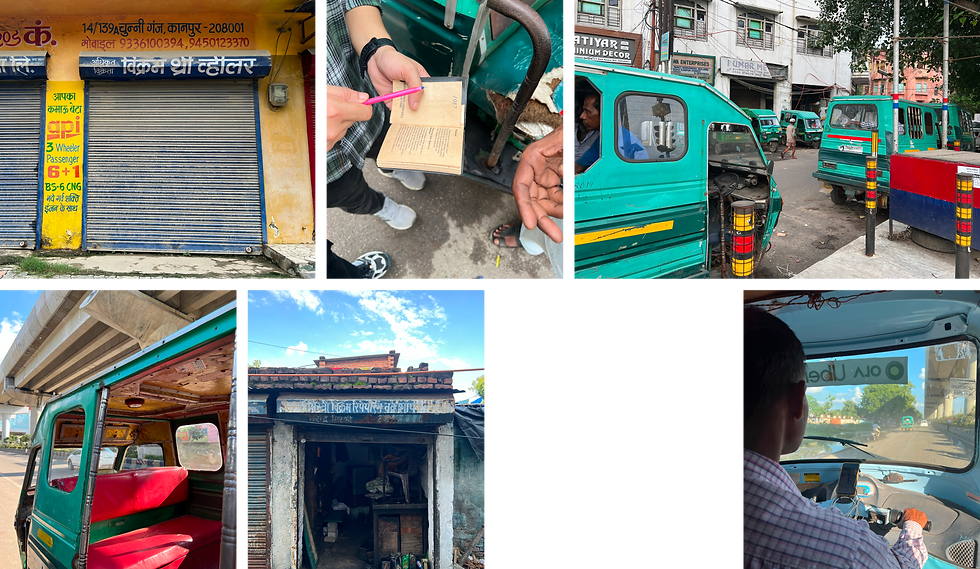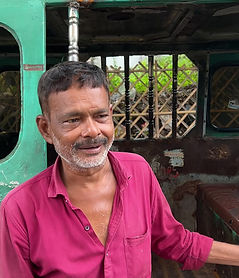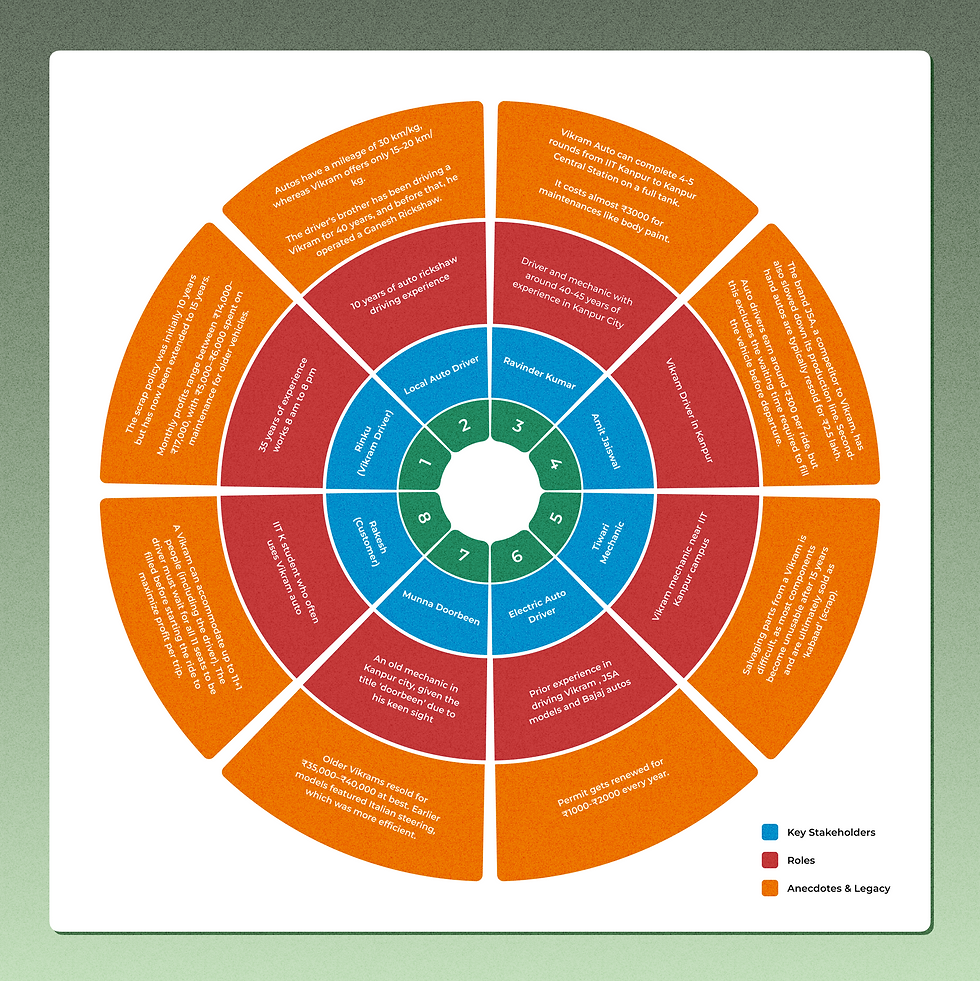Product Designer
Vikram Auto: A study
Vikram autos have long been a pillar of last-mile transport in Uttar Pradesh, offering affordability and reliability. But with rising CNG prices, competition from e-rickshaws, and policy roadblocks, these vehicles are disappearing, leaving drivers struggling to sustain their livelihoods.
Originally built by Scooter India, Vikram autos now face high maintenance costs, scarce spare parts, and shrinking profitability. Yet, their decline isn’t just about outdated technology, it’s about the human impact of an evolving transport ecosystem.
Approaching this issue as a designer, I focused on on-ground research, system mapping, and stakeholder engagement, not just to document the problem but to explore interaction that could offer a sustainable, inclusive path forward. This study identified major systemic challenges that, if addressed, could significantly boost driver income and scale Vikram’s distribution beyond Uttar Pradesh.
Timeline: 2 weeks
Contributor: Individual
Project
Background
The Disappearing Green Machines of Uttar Pradesh
I still remember the first time I hopped onto a Vikram auto in Kanpur. The familiar green shell, the rhythmic hum of the engine, the slight jolt as it maneuvered through chaotic streets, it wasn’t just a ride, it was a slice of the city itself. But as I spoke to drivers and observed the changing landscape of last-mile transport, one thing became clear: the Vikram auto, once a symbol of affordability and reliability, is on the verge of disappearing.
An Unwritten Story of Everyday Hustle
The men who drive these vehicles aren’t just transporters; they’re survivors. One driver, Rajesh, who has been navigating the same route for over a decade, told me how his daily earnings had dwindled over the years. "Pehle din ka 800-1000 mil jata tha, ab mushkil se 500-600 bachta hai" (Earlier, I used to make 800-1000 rupees a day, now I barely save 500-600). Rising CNG prices, increased competition from e-rickshaws, and the mounting cost of repairs have put Vikram drivers in a tough spot.
Most of them bought their vehicles on loans, expecting years of reliable income. But as policies changed and newer, more efficient vehicles flooded the market, the financial stability they once had started slipping away. "License renew karana bhi ab tension ban gaya hai" (Renewing the permit has become a headache now), another driver lamented.
The study on Vikram vehicles began with a visual ethnographic approach, involving contextual inquiry and direct observation of drivers and small business owners in places like Nankari, a village near Kanpur. Many of these individuals come from lower-income backgrounds, relying on Vikram three-wheelers for their daily livelihoods. Through field visits and engagement, their routines, earnings, vehicle maintenance practices, and the broader economic environment were observed. Conversations and interactions highlighted their experiences with shifting policies, evolving market conditions, and the current state of business on the roads.


What went wrong?
Vikram autos were originally manufactured by Scooter India, a government-backed initiative. They are durable, spacious, and built for Indian roads. However, with Scooter India shutting down, production ceased, leaving drivers with an aging fleet that’s increasingly difficult to maintain. Spare parts are scarce, and mechanics often rely on makeshift solutions to keep them running.
At the same time, electric three-wheelers (e-rickshaws) have gained popularity. They’re cheaper to operate, require less maintenance, and most importantly, benefit from a policy push towards electrification. In contrast, Vikram autos are being pushed to the sidelines, victims of an infrastructural shift they were never prepared for.

Visual Ethnography and Contextual Enquiry
As a researcher and designer, I knew that sitting behind a desk and analyzing numbers wouldn’t be enough. To truly understand the Vikram ecosystem, I needed to experience it firsthand. This meant employing a visual ethnographic approach, engaging in contextual inquiries, and embedding myself into the daily lives of drivers, mechanics, and passengers. I didn’t just interview them; I observed them in their natural environment at tea stalls, in workshops, on the bustling streets where they work long hours to make ends meet.
Rather than relying only on a top-down, analytical approach, I decided to immerse myself in the world of Vikram autos. I spent time in mechanics’ workshops, observed repair practices, rode along on trips, and engaged in informal conversations to understand their struggles beyond structured survey questions. This method allowed me to collect rich qualitative data,not just numbers but stories, frustrations, and aspirations.
I also conducted stakeholder interviews and structured Likert-scale surveys to measure perceptions about Vikram autos against emerging transport alternatives. By gathering insights from both drivers and passengers, I could identify patterns that weren’t immediately obvious: trust in Vikram autos still existed, but systemic barriers were forcing their decline.

Engaging with various stakeholders, including Vikram drivers, electric rickshaw drivers, mechanics, and Vikram auto passengers, allowed for a deeper qualitative analysis of the ecosystem. Insights from these conversations contributed to mapping a value proposition curve for Vikram autos, comparing them with other rickshaw options in the market. The data revolved around identifying the key reasons behind the shift away from Vikram vehicles. Was the decline driven by production issues, challenges in obtaining permits and renewals, increasing maintenance costs, or shrinking profit margins? By synthesizing diverse perspectives, patterns began to emerge, revealing how policy changes, economic factors, and evolving consumer preferences were collectively reshaping the viability of Vikram autos in the urban transport landscape.
Understanding the Shifting Landscape of Vikram Autos


Assessing Perceptions: Customer Insights
To understand how customers perceive Vikram autos, quick Likert scale surveys and structured interviews were conducted with regular passengers, occasional users, and those who switched to alternative transport. The focus was on factors like ease of use, comfort, reliability, affordability, and overall satisfaction. Data was gathered through field interactions, ride-along observations, and discussions at transit points. This approach helped identify how passengers compare Vikram autos to electric rickshaws and other three-wheelers, shedding light on shifting preferences and usability concerns.

The Bigger Picture
Lack of Modularity
Unlike some modern three-wheelers, Vikram autos were not designed with modular parts, making repair and retrofitting costly.
Declining Profitability
CNG costs are rising, and fares aren’t increasing proportionally, squeezing drivers’ margins.
Policy Barriers
Vikram drivers struggle with permits, while e-rickshaws enjoy regulatory leniency.
The result? A slow but inevitable phase-out of Vikram autos, despite their potential to still serve urban commuters efficiently.
Through stakeholder conversations, one question kept resurfacing: Could Vikram autos be revived? Drivers believe that if provided with financial assistance to retrofit their vehicles with electric batteries, Vikram autos could still compete. But there’s no clear framework in place for such a transition.
Leveraging Vikram Autos for Sustainable Micro-Mobility
How might we create a sustainable, inclusive framework that allows Vikram auto drivers to transition towards an electric future without losing their livelihoods?
The analysis of Vikram autos through the Life Cycle Assessment (LCA) and circular economy principles reveals a unique opportunity to repurpose and optimize the existing fleet for micro-mobility solutions. Rather than focusing on the traditional end-of-life disposal, Vikram autos already in circulation can be adapted to serve last-mile connectivity needs, particularly in densely populated urban areas. With small-scale, electric conversions, and improved maintenance strategies, Vikram autos can offer an affordable, sustainable alternative to traditional urban transport. By leveraging these vehicles within the framework of shared mobility, recycling components, and integrating clean energy solutions, Vikram autos can not only reduce environmental impact but also enhance mobility access for a wider range of users. This approach aligned with SDG 12: Responsible Consumption and Production, supporting a shift towards more sustainable production and consumption patterns, while contributing to the overall sustainability goals.

A Final Ride

On my last day of study, I took one more Vikram ride. The driver, an older man with graying hair, asked me if I was a student. When I told him about my research, he chuckled, "Bas itna likh do ki humein bhi jeene ka moka mile" (Just write something about us that gives us a chance to survive).
As the Vikram rattled through the city, I realized that this wasn’t just about vehicles, it was about people. For every Vikram auto that disappears, a driver loses his livelihood. A family loses its stability. An entire network of informal urban transport shrinks. This is more than just a story of a vehicle, it’s the story of livelihoods, of a system shifting too fast for some to keep up, and of the human cost of progress.